I have enjoyed three to four medium wave and shortwave DXpeditions per year since 1988, to sites on the Washington and Oregon coasts. I love the chance they give to experiment with antennas in a (hopefully!) noise-free location, and concentrate on catching stations that might not be heard from home.
All of my DX trips have been via car–until now! I’ve just returned from nine vacation days in Hawaii (Waikoloa Beach, on the Big Island), and I thought others might like to see the radio related items I chose to take along for air travel. I’m pleased to report that everything worked as planned, and I have five days of SDR IQ WAV files of the MW band for review, all recorded in the time frame surrounding local dawn.
My goal was not the smallest, most compact portable setup, but one with high performance and modest size. Fitting everything into a day pack was another requirement. A simple wire antenna and an even smaller Windows tablet or laptop than the one I’ve used (and a smaller SDR like the HF+ Discovery, for that matter) would make a much smaller package. However, the items I’ve assembled worked excellently for me during my enjoyable Hawaii vacation. The directional loop antenna provided nulls on medium wave of 30 dB during preliminary tests indoors, a less-than-ideal test situation.
Here is a list of what I’ve put together for my DXing “kit”:
-
- SDRPlay RSPdx receiver
- Short USB cable for receiver<>PC connection, with two RFI chokes installed
- Lenovo X1 tablet— a Windows 10 device with magnetically attached keyboard; this model is a competitor to Microsoft’s Surface Pro tablet
- Wellbrook Communications’ ALA1530 head amp module, modified for female SO239 connectors enabling use of large diameter LMR-600 coaxial cable as a 2-turn loop element. My antenna setup is similar to Wellbrook’s commercial flexible loop
- Wooden base for the antenna (ALA1530 is bolted to the base)
- 20 feet of lightweight RG-174 coax
- Wellbrook DC interface module for the ALA1530
- 3.0 Ah LiFePO4 rechargeable battery for the Wellbrook antenna
- 15 foot long section of high grade “Times Mfg.” LMR-600 coax cable with PL259 connectors (bought from Ebay already assembled/soldered)
- Fold-up beach mat
- Small day pack to hold everything
You’ll note the absence of headphones in the list. This is because my intent from the start was to record all the DX (MW band) as SDR WAV files for DXing post-vacation. That said, I did have headphones in my travel luggage for later spot checks of a few frequencies. That’s how I found 576 kHz Yangon, Myanmar lurking at their 1700 sign-off with national anthem and English announcement. The remainder of the DX to be uncovered will have to wait until I’m back home near Seattle!
The LMR-600 is a very thick and stiff coax cable, whose diameter approaches that used in the standard aluminum tubing ALA1530 series from Wellbrook. It has the benefit of being self-supporting in a 2-turn configuration and will also coil up into an approx. 12-inch package for transport. It just barely fits within the day pack I’m using. As I understand it, magnetic loops with tubing or large coax as the active element, versus simple wire, are more efficient in operation. Whether or not this holds true in practice remains to be seen.
I fashioned a wooden disc 3/4″ thick to attach the ALA1530 head amplifier, as I didn’t want to bring along a tripod or other support stand. The Wellbrook antennas all work well near or at ground level, so I was able to get great reception with the antenna right on the beach. The diameter at two turns of the coax is only a few inches smaller diameter than Wellbrook’s aluminum tubing loops. Three strips of strategically placed Velcro straps help keep the turns together when deployed as well as during storage.
In theory a two-turn loop should give 5 dB less gain than a single turn version; however, my older ALA1530 module has 5 dB more gain than the newer “LN” type, according to Andrew Ikin of Wellbrook Communications. The net result is that my two-turn antenna should have equal gain to the larger one-turn variety. Future experimentation with this DIY coax loop antenna is in order!
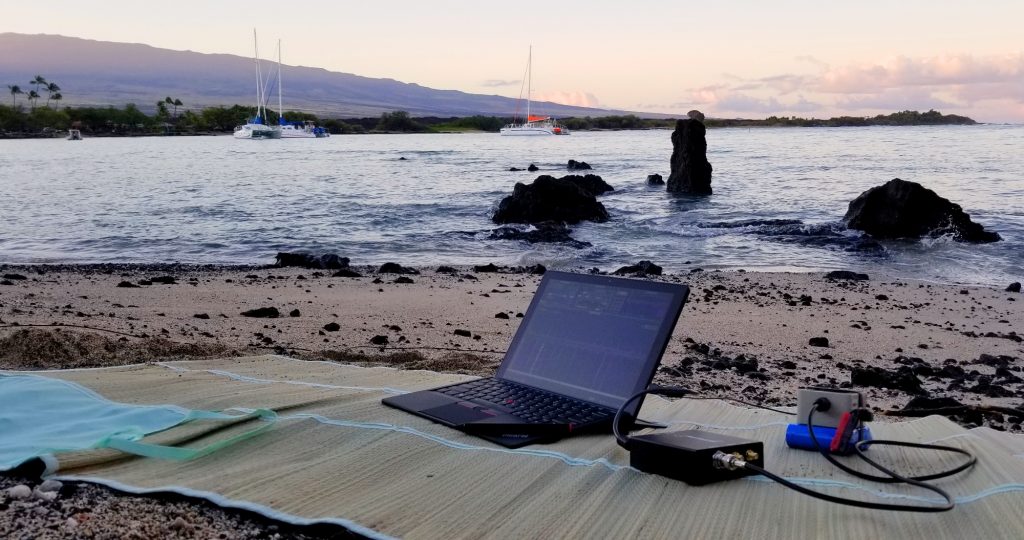
Another view of the DXing position. Being this close to the water with my radio gear was unnerving at first, but the wave action on a calm Hawaii beach is totally different from the Oregon/Washington beaches with waves that can move in and out by a hundred feet or more.
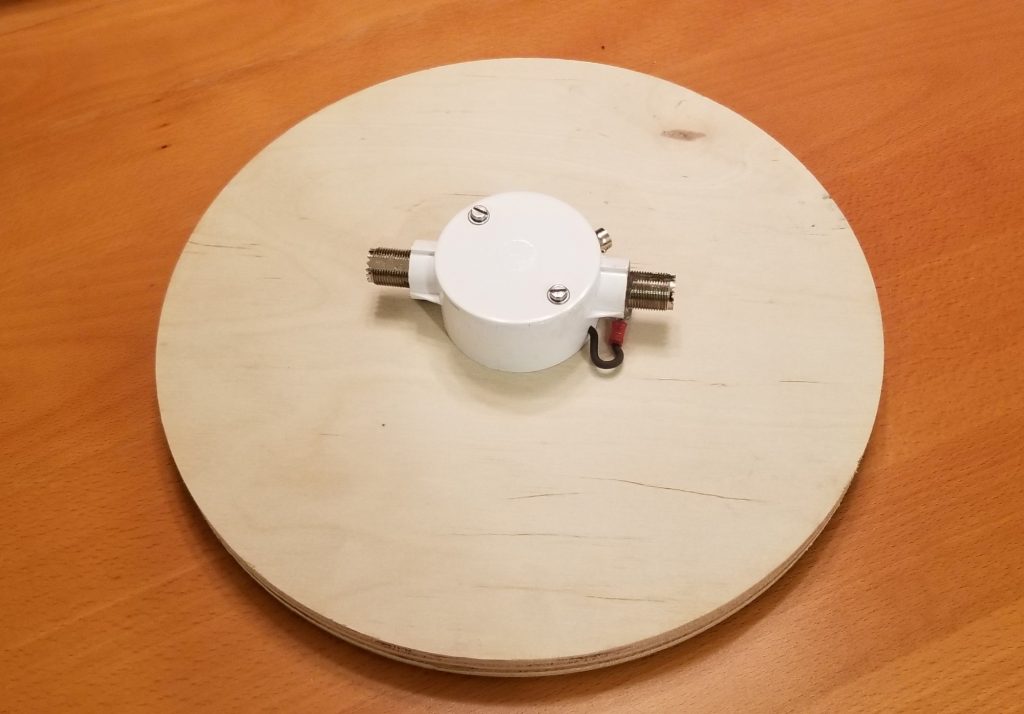
The ALA1530 module is bolted to the 11-inch wooden disc for support. I’ve modified the module’s sockets to securely hold SO239 female connectors.
The commercial Wellbrook FLX1530LN is a fine product, and worthy of your consideration as a compact and high performance travel antenna. Full details can be found at this link.
SDR WAV Files for Download
One of my goals from the start for my Hawaii trip was to bring back SDR “IQ” WAV files for sharing with others. These approx. 900 Mb files cover the entire medium wave band as heard from my beach location in Waikoloa.
The overall page is: https://archive.org/details/@4nradio Clicking on any of the entries will bring you to a details page. From there just right click on the “WAVE” link, and choose “Save as…” to download. For a few of the recordings I also posted the file that precedes the one that goes across the top-of-the-hour, because things seemed a bit more lively prior to 1700 (which was at local sunrise, give or take a couple of minutes).
The IQ WAV files are only playable with suitable SDR radio software: SDRuno is first choice (but you need a RSP receiver connected). The files are also is compatible with HDSDR and SDR-Console V3. It may also play on Studio 1 software.
I hope other DXers enjoy the chance to tune through the MW band, as heard from the Big Island of Hawaii.
Guy Atkins is a Sr. Graphic Designer for T-Mobile and lives near Seattle, Washington. He’s a regular contributor to the SWLing Post.

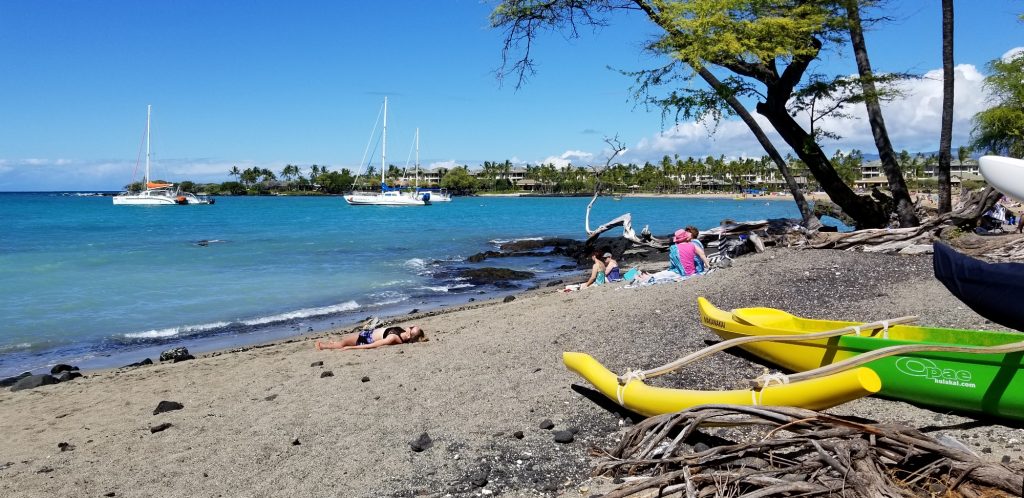
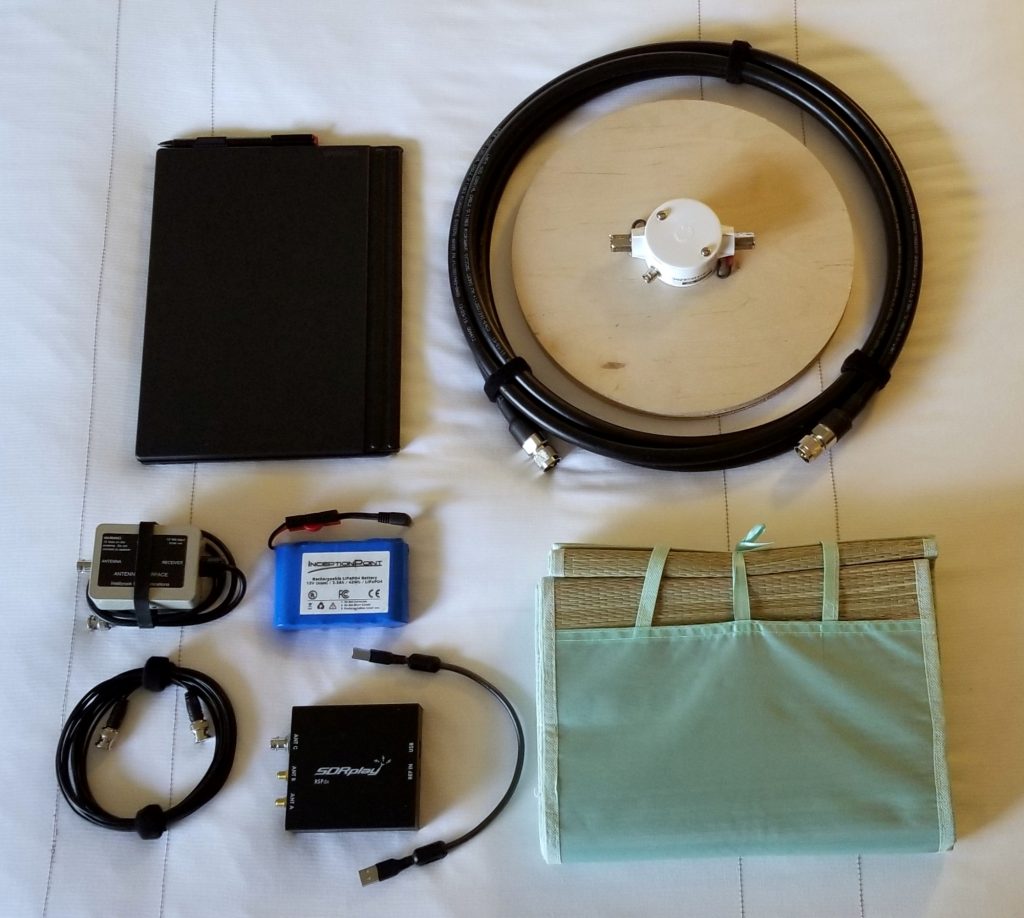
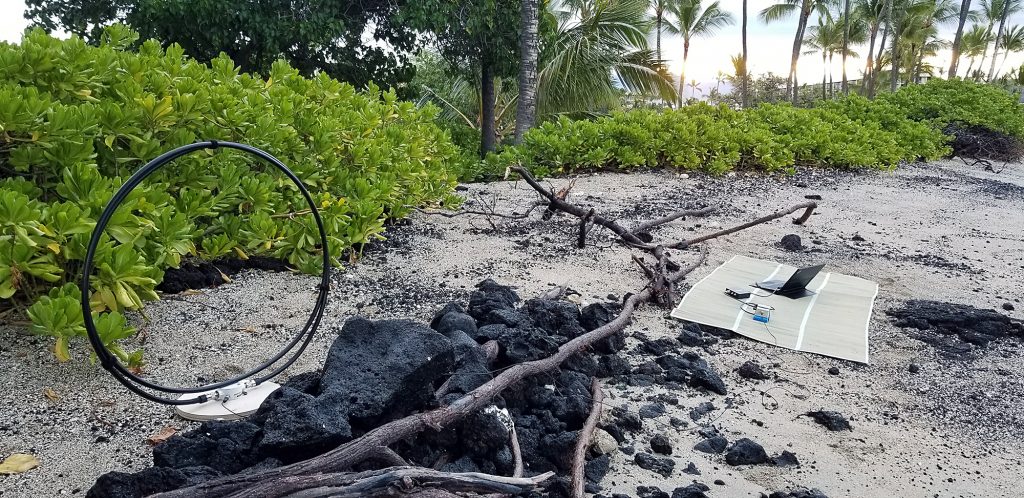
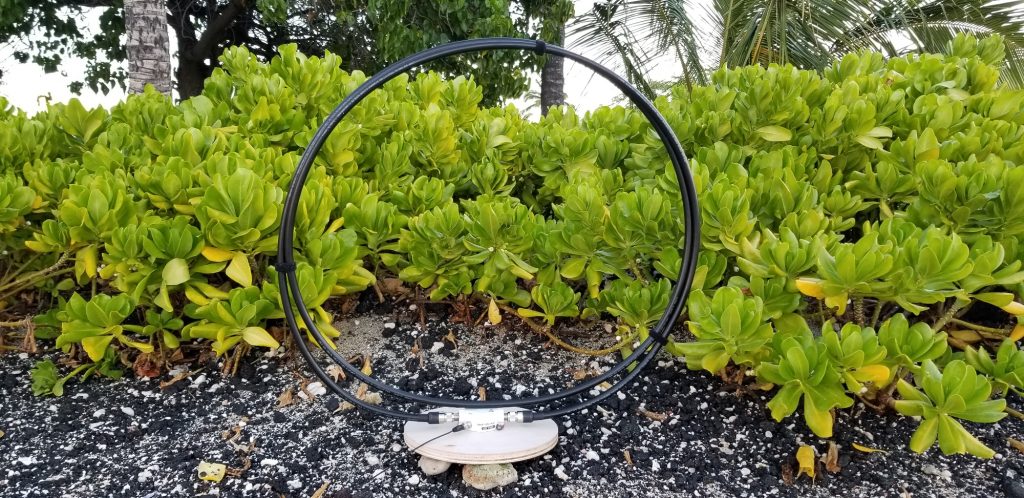
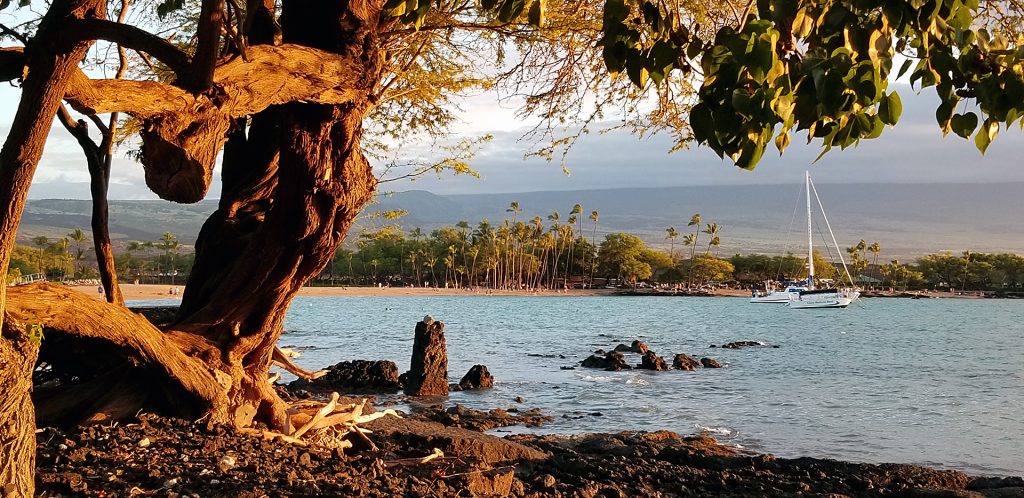
Hi Guy, very interesting post as usual. You piqued my curiosity by saying a magnetic loop with tubing or large coax, versus simple wire, is more efficient. I’d love to hear more about this as Wellbrook do sell a simple wire model (the ALA100LN) which has the added advantage of being of the low noise variety. Andy Ikin’s site is not very explicit about this. Your opinion?
Hi Andrew, sorry for the late reply. I do not recall where I read this information, I think it was on some amateur radio site about home brew magnetic loops. These are similar in size to the 1-meter Wellbrook models. There was discussion about tubing or pipe being of a lower inductance (?) than a typical diameter of wire, and therefore more efficient or otherwise desirable. Perhaps the tubing option applies only to loops that can be tuned to resonance, versus broadband?
I did ask Andy at Wellbrook about the tubing question and he did not think that you would be able to tell any performance difference. So, perhaps on the Wellbrook loops the tubing elements (ALA1530 etc.) and the large diameter coax elements (FLX1530LN) serve mainly a structural purpose to keep the loop erect and rigid.
It would be great if someone more knowledgeable than myself on antenna theory would comment on this tubing (or large coax) vs. wire question for small magnetic loops!
Is this Waikoloa? My son and I did QRP there https://s3.amazonaws.com/files.qrz.com/y/n1spy/N1SPY_1.jpg
Yes, it is Waikoloa beach, near the Marriott resort where my wife and I stayed. It’s a wonderful location!
Wonderful report, Guy. Thank you.
Last month I read Thomas’ excellent article in the Spectrum Monitor about portable SDR dxing. One of the notes he made that really caught my attention was the fact using a portable kit like this allows you to ‘set it and forget it’ in essence. Set up the radio to make recordings, then go spend time on vacation with your family. Do the DXing back home and relive the moment! Best of both worlds, if you ask me.
That article and this one has prompted me to take the plunge and design a portable SDR kit around my recently acquired RSPdx. The XYL is pretty generous allowing me to play radio when we vacay, but I do miss just hanging with her and enjoying the moment even more than the radio play. (Wait…did I just say that out loud?)
Thanks for the inspiration!
73,
Marc
Great article, Guy. I’m looking forward to taking my SDR camping this Summer along the Oregon and California coastline. I’m plagued with extreme RF at home. Thanks for the great write up!
Keep an eye on the tides, I don’t think your equipment will perform well under water.
Absolutely… I kept a wary eye on the water line. It was very calm at sunrise though with small waves moving in and out by a couple of feet… almost like on the shore of a lake. My morning DXing sessions were only about 45 minutes each and there was no noticeable advancing of a tide line.
I noticed throughout the days of my trip that the extent of the tides was *very* minor compared to what I observe at the much higher latitude of Washington State where I live.
Hi Guy:
So what is involved in removing the existing connectors and installing the PL259s?
And I didn’t understand the Velcro straps. What do they do when the antenna is deployed?
Chuck
Hi Chuck,
The Velcro straps just serve to keep the two turns of the loop nice & tidy, adjacent to each other so they don’t have any chance to flop around. During transport the Velcro keeps the tightly coiled loop element secure & bundled.
There were no existing connectors on the ALA1530 head module I used; just empty PVC “sockets” that the Wellbrook Aluminum tubing loop normally inserts into. Wellbrook sold the modules this way as replacement parts for the 1530 loops (the aluminum tubing loop from the old antenna gets reused on the new module).
Andrew at Wellbrook also asked me today about how I installed the SO239s on the ALA1530 module, so I’m copying the steps I described:
——————————
Using a radial saw I cut off about 1/4-inch of length of each tube socket, because the connectors were going to extend past the end of each socket some distance and I didn’t want the overall connector-socket distance to be too great (possibility for flex & breakage). I smoothed the ends of the cut sockets with sand paper. I wanted the solder-end of the SO239 to be as close to the solid resin (epoxy?) interior “wall” of each socket as possible. Of course, no use is made of the solder end of the SO239; I also removed the little back-end “tube” where you normally solder the center conductor of a chassis-mount SO239. My goal was to have the PVC sockets and the SO239s as short as possible. This is the exact SO239 style I used: https://www.amazon.com/gp/product/B07VPMT6QY/ref=ppx_yo_dt_b_search_asin_title?ie=UTF8&psc=1 . BTW I discarded the rubber grommet shown in the photo.
I enlarged the I.D. of each PVC head module socket with a sharp #11 X-acto (hobby) knife to make the socket a firm press-fit with the rear body of the SO239. Ideally this would be done on a lathe and a sharp milling bit. I tried using a brand new drill bit in my drill press but that was going to be disaster if I proceeded. The I.D. of the sockets need to be enlarged only a little bit, maybe 0.01-0.015″, so doing it by hand with the sharp blade was sufficient, followed with some fine sand paper.
I filled the sockets with extra strong 2-part epoxy, pressed the SO239s into the head module as far as possible (took a good amount of pressure) and let the assembly fully harden (over 24 hours).
Then I drilled a single pilot hole per socket into the end of the shortened socket, at the existing fastener holes (which normally attaches to the aluminum hoop). My drilling extended into the body of the SO239 itself. Then using stainless steel screws I fastened the flying leads’ lugs to the SO239 to create the electrical connection to the shield of the coax loop element. The result is a very solidly mounted SO239, suitable for supporting LMR400 / LMR600 coax cable loops with PL259s, which are more sturdy for such use than BNCs.
This is a very compelling setup. Even on battery power does the laptop introduce unwanted noise into this system? I love the flexible Wellbrook antenna. Does it perform as well as the rigid ones?
Brian, to my knowledge I had no RFI noise issues with the setup I took to Hawaii. The Lenovo X1 is not the usual WIndows computer I take on DXpeditions, but it is by far the most portable. In my experience it is the laptop or tablet’s power supply that’s the usual problem. In my scenario of just using battery at the beach the chance of QRM is even less. Also, as you noticed I used a lithium-Ion battery for the Wellbrook antenna interface, so no chance of noise with that.
Wellbrook antennas have always been excellent at decoupling the antenna from the coax feed line, so common mode noise is kept under control. Also, the loop element itself is directional so that helps reduce noise if you orient it broadside to any RFI sources.
I haven’t yet directly compared the flexible loop against my two rigid aluminum Wellbrook loops (ALA1530S+ and ALA1530LNP models). So, I can’t say if performance is the same. I’ll be back on another coastal DXpedition to Oregon in March however… sounds like a chance for a good A-B test!
Finally, the RSPdx has a very low power requirement and is one of the reasons I like it for portable DXing. It takes only 120 ma. current via the USB cable from the laptop.
Hi Dan, it is a 15-foot length. The diameter of the two-turn loop with this length is about 28-29 inches.
What is the length of your LMR600 for this antenna?